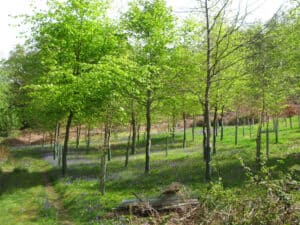Planting trees – an informed viewpoint
 Patrick Mannix is a local resident and has been a practicing owner/operator of Sandhurst Copse & Sheepwalk woodland in the Surrey Hills AONB for the last 20 years. He has lectured and hosted visits by the Surrey Hills Society and many members take advantage of his “managed access” system, giving permission to walk in the woodland. Interacting with nature every day, observing and learning, he has been curious about nature and natural processes since his grandfather taught him the names of trees in the 1940s. Now, as a grandfather himself, his concerns are about the world our grandchildren will grow up in and how we can learn to respect our natural environment before it is too late.
Patrick Mannix is a local resident and has been a practicing owner/operator of Sandhurst Copse & Sheepwalk woodland in the Surrey Hills AONB for the last 20 years. He has lectured and hosted visits by the Surrey Hills Society and many members take advantage of his “managed access” system, giving permission to walk in the woodland. Interacting with nature every day, observing and learning, he has been curious about nature and natural processes since his grandfather taught him the names of trees in the 1940s. Now, as a grandfather himself, his concerns are about the world our grandchildren will grow up in and how we can learn to respect our natural environment before it is too late.
The growing awareness of the need to plant trees and respect other aspects of nature is very welcome; but with a little caution. Nature is such a complex web of interaction between the smallest invisible organisms comprising the microbiome of the soil, and the larger ones that we can see, that almost any action, however well intended, will have an adverse reaction somewhere. Only nature left to itself over a long time can create biodiversity, we do not have a sufficient grasp of the underpinnings. We seem only able to damage it.

To help nature, we should start by understanding what we already have, supporting and promoting that which does well. If we wish to try new species in the expectation that they may benefit from or be better able to withstand climate change, then plant a few as a test, indeed plant a few of different types. When I was managing herbaceous borders that we inherited with our house in Shamley Green, I would always buy several of a new plant, or of several different plants and then only buy more of the ones that were happy in that location and succeeded. In Sandhurst Copse & Sheepwalk woodland for 20 years I have only planted seed or seedlings from trees already in the wood, on the basis that if the mother tree is happy then it increases the chance that the seedlings will be happy, in that location. I am now experimenting with some additional species, eg wild service trees; but again, plant a few and only replicate those that show success. If you want to try wildflower seeds, then do so on an isolated test site, and monitor what happens to the already established species and only try one new species at a time. Only promote those that do well but do not overwhelm the existing inhabitants.
Be cautious regarding tree planting schemes. If you want to plant a tree, then decide what type of tree for what purpose. It should then be planted in a suitable location for that purpose. Trees do need some management in particular to prevent damage from rodents, rabbits, deer and squirrels, is that going to be provided? Also, whilst planting a tree is touted as a contribution to addressing climate change, it should not be an excuse for failing to take other action. Our most significant contribution to addressing climate change is by adjusting our lifestyle regarding long haul flights, motor vehicles, consumption of beef and dairy products, unnecessary purchases and cutting out any excess. Do not plant a tree until you have, at least, decided on your own personal actions.



